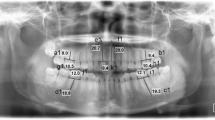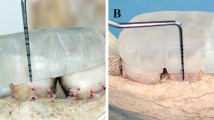Abstract
Purpose
We determined actual bucco-lingual angulation values and morphological variations of residual bone in the mandibular posterior edentulous region using cone-beam computed tomography (CBCT) and panoramic radiography. A second aim was to investigate whether it was possible to predict bone morphology from panoramic radiographs.
Methods
Data were collected from 77 consecutive patients referred for both CBCT and panoramic radiography in our department. Two-dimensional and three-dimensional images of the probable implant placement region were investigated. The bucco-lingual angulation values and crest type were determined directly from the cross-sectional images of the posterior edentulous region. The edentulous region was divided into three groups: second premolar, first molar, or second molar region. The observations were evaluated by the computer software, SPSS 22.0 (SPSS Inc. Chicago, USA). The crest type was classified into three groups: type U, type C, or type P. Kappa statistics, Kolmogorov–Smirnov tests, ANOVA, and Kruskal–Wallis tests were used in statistical analyses. The significance level was set at p < 0.05.
Results
Type C was more frequent in the second premolar region and the crest type had changed to type U in the second molar region. The predictability of the type U was highest in the second molar region. Moderate agreement was found in the predictability of type U in the molars (κ = 0.602). The mean value of bucco-lingual angulation was highest in the second molar region, followed by the first molar region. There were statistically significant differences between the bucco-lingual angulation of the crest types in the second premolar and first molar regions (p < 0.05).
Conclusions
Bucco-lingual angulation values and morphology change through the posterior mandible. Type U was predicted at a higher rate in the second molar region from panoramic radiographs. These results demonstrate predicting high-risk areas in the posterior mandible for implant therapy from panoramic radiography.



Similar content being viewed by others
References
Abrahams JJ (1993) Anatomy of the jaw revisited with a dental CT software program. AJNR Am J Neuroradiol 14:979–990
Akca K, Iplikcioglu H (2001) Evaluation of the effect of the residual bone angulation on implant-supported fixed prostheses in mandibular posterior edentulism. Part I: spiral computed tomography study. Implant Dent 10:216–222
Akca K, Iplikcioglu H (2001) Evaluation of the effect of the residual bone angulation on implant-supported fixed prosthesis in mandibular posterior edentulism. Part II: 3-D finite element stress analysis. Implant Dent 10:238–245
Almog DM, Onufrak JM, Hebel K, Meitner SW (1995) Comparison between planned prosthetic trajectory and residual bone trajectory using surgical guides and tomography—a pilot study. J Oral Implantol 21:275–280
Chan HL, Benavides E, Yeh CY, Fu JH, Rudek IE, Wang HL (2011) Risk assessment of lingual plate perforation in posterior mandibular region: a virtual implant placement study using cone-beam computed tomography. J Periodontol 82:129–135
Chan HL, Brooks SL, Fu JH, Yeh CY, Rudek I, Wang HL (2011) Cross-sectional analysis of the mandibular lingual concavity using cone beam computed tomography. Clin Oral Implants Res 22:201–206
Dao TT, Mellor A (1998) Sensory disturbances associated with implant surgery. Int J Prosthodont 11:462–469
Feingold GM, Grant AA, Johnson W (1988) The effect of variation of residual ridge angle on partial denture abutment tooth movement. J Oral Rehabil 15:379–384
Isaacson TJ (2004) Sublingual hematoma formation during immediate placement of mandibular endosseous implants. J Am Dent Assoc 135:168–172
Ismail YH, Azarbal M, Kapa SF (1995) Conventional linear tomography: protocol for assessing endosseous implant sites. J Prosthet Dent 73:153–157
Jemt T, Lekholm U (1993) Oral implant treatment in posterior partially edentulous jaws: a 5-year follow-up report. Int J Oral Maxillofac Implants 8:635–640
Kalpidis CD, Setayesh RM (2004) Hemorrhaging associated with endosseous implant placement in the anterior mandible: a review of the literature. J Periodontol 75:631–645
Kopp KC, Koslow AH, Abdo OS (2003) Predictable implant placement with a diagnostic/surgical template and advanced radiographic imaging. J Prosthet Dent 89:611–615
Lee SY, Morgano SM (1994) A diagnostic stent for endosseous implants to improve conventional tomographic radiographs. J Prosthet Dent 71:482–485
Leong DJ, Chan HL, Yeh CY, Takarakis N, Fu JH, Wang HL (2011) Risk of lingual plate perforation during implant placement in the posterior mandible: a human cadaver study. Implant Dent 20:360–363
Misch CE, Bidez MW (1994) Implant-protected occlusion: a biomechanical rationale. Compendium 15:1330–1332 (1334 passim quiz 1344)
Niamtu J 3rd (2001) Near-fatal airway obstruction after routine implant placement. Oral Surg Oral Med Oral Pathol Oral Radiol Endod 92:597–600
Parnia F, Fard EM, Mahboub F, Hafezeqoran A, Gavgani FE (2010) Tomographic volume evaluation of submandibular fossa in patients requiring dental implants. Oral Surg Oral Med Oral Pathol Oral Radiol Endod 109:e32–e36
Quirynen M, Mraiwa N, van Steenberghe D, Jacobs R (2003) Morphology and dimensions of the mandibular jaw bone in the interforaminal region in patients requiring implants in the distal areas. Clin Oral Implants Res 14:280–285
Sahman H, Sekerci AE, Ertas ET (2014) Lateral lingual vascular canals of the mandible: a CBCT study of 500 cases. Surg Radiol Anat 36:865–870
Todd AD, Gher ME, Quintero G, Richardson AC (1993) Interpretation of linear and computed tomograms in the assessment of implant recipient sites. J Periodontol 64:1243–1249
van Steenberghe D, Lekholm U, Bolender C, Folmer T, Henry P, Herrmann I, Higuchi K, Laney W, Linden U, Astrand P (1990) Applicability of osseointegrated oral implants in the rehabilitation of partial edentulism: a prospective multicenter study on 558 fixtures. Int J Oral Maxillofac Implants 5:272–281
Watanabe H, Mohammad Abdul M, Kurabayashi T, Aoki H (2010) Mandible size and morphology determined with CT on a premise of dental implant operation. Surg Radiol Anat 32:343–349
Yildiz S, Bayar GR, Guvenc I, Kocabiyik N, Comert A, Yazar F (2015) Tomographic evaluation on bone morphology in posterior mandibular region for safe placement of dental implant. Surg Radiol Anat 37:167–173
Zarb GA (1989) Implant prosthodontics: the advent of osseointegration. J Can Dent Assoc 55:335
Author information
Authors and Affiliations
Corresponding author
Ethics declarations
Conflict of interest
The authors state that there are no conflicts of interest.
Rights and permissions
About this article
Cite this article
Çiftçi, M.E., Aktan, A.M., İşman, Ö. et al. Relationship between CBCT and panoramic images of the morphology and angulation of the posterior mandibular jaw bone. Surg Radiol Anat 38, 313–320 (2016). https://doi.org/10.1007/s00276-015-1553-1
Received:
Accepted:
Published:
Issue Date:
DOI: https://doi.org/10.1007/s00276-015-1553-1




